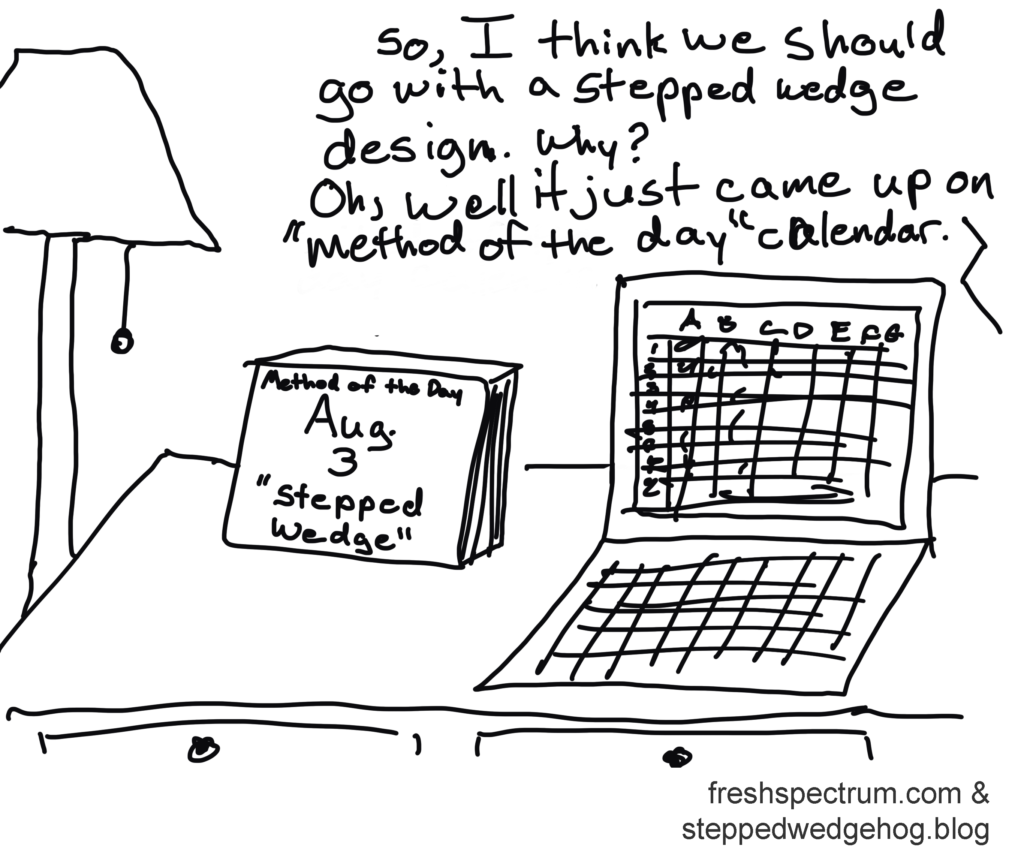
When following links to journal articles in the sections below, note that some journals will require an institutional login or subscription.
Go straight to:
or scroll down for more.
Reporting guidelines
The CONSORT guidance on how to report findings from stepped wedge trials can be found here:
- Hemming K, Taljaard M, McKenzie JE, et al. Reporting of stepped wedge cluster randomised trials: extension of the CONSORT 2010 statement with explanation and elaboration. BMJ 2018;363:k1614.
Reflective articles
Here are some more reflective articles on stepped wedge trials from academic journals:
- Hargreaves JR, Copas AJ, Beard E, et al. Five questions to consider before conducting a stepped wedge trial. Trials 2015;16:350.
- Prost A, Binik A, Abubakar I, et al. Logistic, ethical, and political dimensions of stepped wedge trials: critical review and case studies. Trials 2015;16:351.
- Hooper R, Copas A. Stepped wedge trials with continuous recruitment require new ways of thinking. J Clin Epidemiol 2019;116:161-166.
- Hemming K, Taljaard M. Reflection on modern methods: when is a stepped wedge cluster randomized trial a good design choice? Int J Epidemiol 2020;doi:10.1093/ije/dyaa077.
- Hooper R, Eldridge S. Cutting edge or blunt instrument: how to decide if a stepped wedge design is right for you. BMJ Quality Safety 2020;doi:10.1136/bmjqs-2020-011620.
- Binik A. Delaying and withholding interventions: ethics and the stepped wedge trial. J Med Ethics 2019;45:662-667.
- Hooper R. Key concepts in epidemiology: stepped wedge trials. J Clin Epidemiol 2021;doi:10.1016/j.jclinepi.2021.04.003.
And here is a helpful YouTube video on cluster randomised and stepped wedge trials by Sandra Eldridge:
Analysis
For a comprehensive discussion of mixed effects models for the analysis of stepped wedge trials:
- Li F, Hughes JP, Hemming K, et al. Mixed-effects models for the design and analysis of stepped wedge cluster randomized trials: an overview. Stat Methods Med Res 2020;doi:10.1177/0962280220932962.
For permutation tests and approaches with less reliance on modelling assumptions:
- Thompson JA, Davey C, Fielding K, et al. Robust analysis of stepped wedge trials using cluster-level summaries within periods. Stat Med 2018;37:2487-500.
- Thompson J, Davey C, Hayes R, et al. Permutation tests for stepped-wedge cluster-randomized trials. Stata J 2019;19:803-819.
- Kennedy-Staffer L, de Gruttola V, Lipsitch M. Novel methods for the analysis of stepped wedge cluster randomised trials. Stat Med 2020;39:815-844.
Sample size calculation
Software packages and apps for sample size calculation for stepped wedge trials:
- The Shiny CRT Calculator: R Shiny app for calculating power and sample size for cluster randomised trials (including stepped wedge).
- swdpr: SAS macro and R package for calculating power for stepped wedge trials with continuous or binary outcomes.
- SWSamp: R package for calculating sample size for stepped wedge trials by simulation.
- swCRTdesign: R Shiny app for calculating power for stepped wedge designs.
And some useful journal articles on sample size calculation, for background:
- Hooper R, Bourke L. Cluster randomised trials with repeated cross sections: alternatives to parallel group designs. BMJ 2015;350:h2925.
- Hooper R, Teerenstra S, de Hoop E, Eldridge S. Sample size calculation for stepped wedge and other longitudinal cluster randomised trials. Stat Med 2016;35:4718-4728.
- Girling AJ. Relative efficiency of unequal cluster sizes in stepped wedge and other trial designs under longitudinal or cross‐sectional sampling. Stat Med 2018;37:4652-4664.
- Li F, Turner EL, Preisser JS. Sample size determination for GEE analyses of stepped wedge cluster randomized trials. Biometrics 2018;74:1450-1458.
- Teerenstra, Taljaard, Haenen, et al. Sample size calculation for stepped-wedge cluster-randomized trials with more than two levels of clustering. Clinical Trials 2019;16:225-236.
- Kasza J, Hooper R, Copas A, Forbes AB. Sample size and power calculations for open cohort longitudinal cluster randomized trials. Stat Med 2020;doi:10.1002/sim.8519.
- Li F. Design and analysis considerations for cohort stepped wedge cluster randomized trials with a decay correlation structure. Stat Med 2020;39:438–455.
- Zhou X, Liao XM, Kunz LM, et al. A maximum likelihood approach to power calculations for stepped wedge designs of binary outcomes. Biostatistics 2020;21:102-121.
- Liu J, Colditz GA. Sample size calculation in three‐level cluster randomized trials using generalized estimating equation models. Stat Med 2020;39:3347-3372.
- Hemming K, Kasza J, Hooper R, et al. A tutorial on sample size calculation for multiple-period cluster randomized parallel, cross-over and stepped-wedge trials using the Shiny CRT Calculator. Int J Epidemiol 2020;doi:10.1093/ije/dyz237.
- Harrison LJ, Wang R. Power calculation for analyses of cross-sectional stepped-wedge cluster randomized trials with binary outcomes via generalized estimating equations. Stat Med 2021;doi:10.1002/sim.9205.
Reviews
Systematic reviews of stepped wedge trials:
- Brown CA, Lilford RJ. The stepped wedge trial design: a systematic review. BMC Med Res Methodol 2006;6:54.
- Mdege ND, Man MS, Taylor Nee Brown CA, Torgerson DJ. Systematic review of stepped wedge cluster randomized trials shows that design is particularly used to evaluate interventions during routine implementation. J Clin Epidemiol 2011;64:936-48.
- Beard E, Lewis JJ, Copas A, et al. Stepped wedge randomised controlled trials: systematic review of studies published between 2010 and 2014. Trials 2015;16:353.
- Davey C, Hargreaves J, Thompson JA, et al. Analysis and reporting of stepped wedge randomised controlled trials: synthesis and critical appraisal of published studies, 2010 to 2014. Trials 2015;16:358.
- Barker D, McElduff P, D’Este C, Campbell MJ. Stepped wedge cluster randomised trials: a review of the statistical methodology used and available. BMC Med Res Methodol 2016;16:69.
- Martin J, Taljaard M, Girling A, Hemming K. Systematic review finds major deficiencies in sample size methodology and reporting for stepped-wedge cluster randomised trials. BMJ Open 2016;6:e010166.
- Grayling MJ, Wason JM, Mander AP. Stepped wedge cluster randomized controlled trial designs: a review of reporting quality and design features. Trials 2017;18:33.
- Taljaard M, Hemming K, Shah L, et al. Inadequacy of ethical conduct and reporting of stepped wedge cluster randomized trials: Results from a systematic review. Clin Trials 2017;14:333-341.
More
Additional resources, journal references and other information on stepped wedge trials for researchers can be found here.
